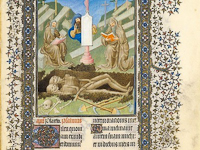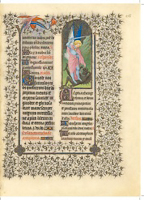| E-mail me at mcclainm@optonline.net | Visit my Facebook page | View my LinkedIn profile |

Yesterday, Good Friday, I took the train into the city, rode the subway to 81st Street and walked across the park to the Museum in search of a once in a lifetime chance to see the entire book in its original.
The exhibition, titled "The Art of Illumination: the Limbourg Brothers and the Belles Heures of Jean de France, Duc de Berry", contains 180 manuscript pages and other artifacts from the Duc's collection. Each leaf is displayed in an individual glass case in the Robert Lehman wing on the ground floor of the museum.
The displays are grouped in sections: Prayers to the Virgin, the Hours of the Passion [very suitable for Good Friday], Readings from the Gospels, and so on. A few unusual sections – on Heraclius and the True Cross; the Life of St. Catherine of Alexandra; and Diocrès, Bruno, and Carthusians, for example – provide a peek into themes scarcely known today.
 |
| St. Michael the Archangel |
When the illustrations from this book are reproduced in modern-day books, they are typically enlarged to show the intricate detail of the paintings. Although they are impressive in their enlarged versions, they are even more stunning in their original miniature versions. Squinting through a magnifying glass (thoughtfully provided by the museum) – tracing the fine detail of the pictures– I marveled at the exquisite skill of the artists.
The name with which the Belles Heures is most often associated is Jean de France, Duc de Berry, the wealthy collector of the arts who commissioned it. But in this exhibit, the young artists who executed it receive equal billing. They were three brothers – Herman, Paul, and Jean de Limbourg – who came from the Netherlands into the duke's service when they were in their late teens and stayed with him until their deaths from the plague in 1416. Little is known of their lives, except through their association with the Duc, but their intelligence, humor and talent are easily recognized in their illustrations.
I suppose the book needs to be sewn together again, but when it is, few people will ever see its illustrations except in reproduction. Too bad that this 'never to be repeated' event cannot be repeated every now and again.
The museum's website contains extensive information about the exhibition.
The Belles Heures is a permanent part of the collection of the Museum of Modern Art at the Cloisters.
Note added on June 23, 2010: Many of its pages have their source in the Legenda Aurea (Golden Legends), a collection saints' lives compiled by Jacobus a Voragine in 1275 (translated into English in 1483 by William Caxton).
Note added on June 20, 2011: It turns out that the opportunity was repeated. A return visit is described in my June 23, 2010 blog.